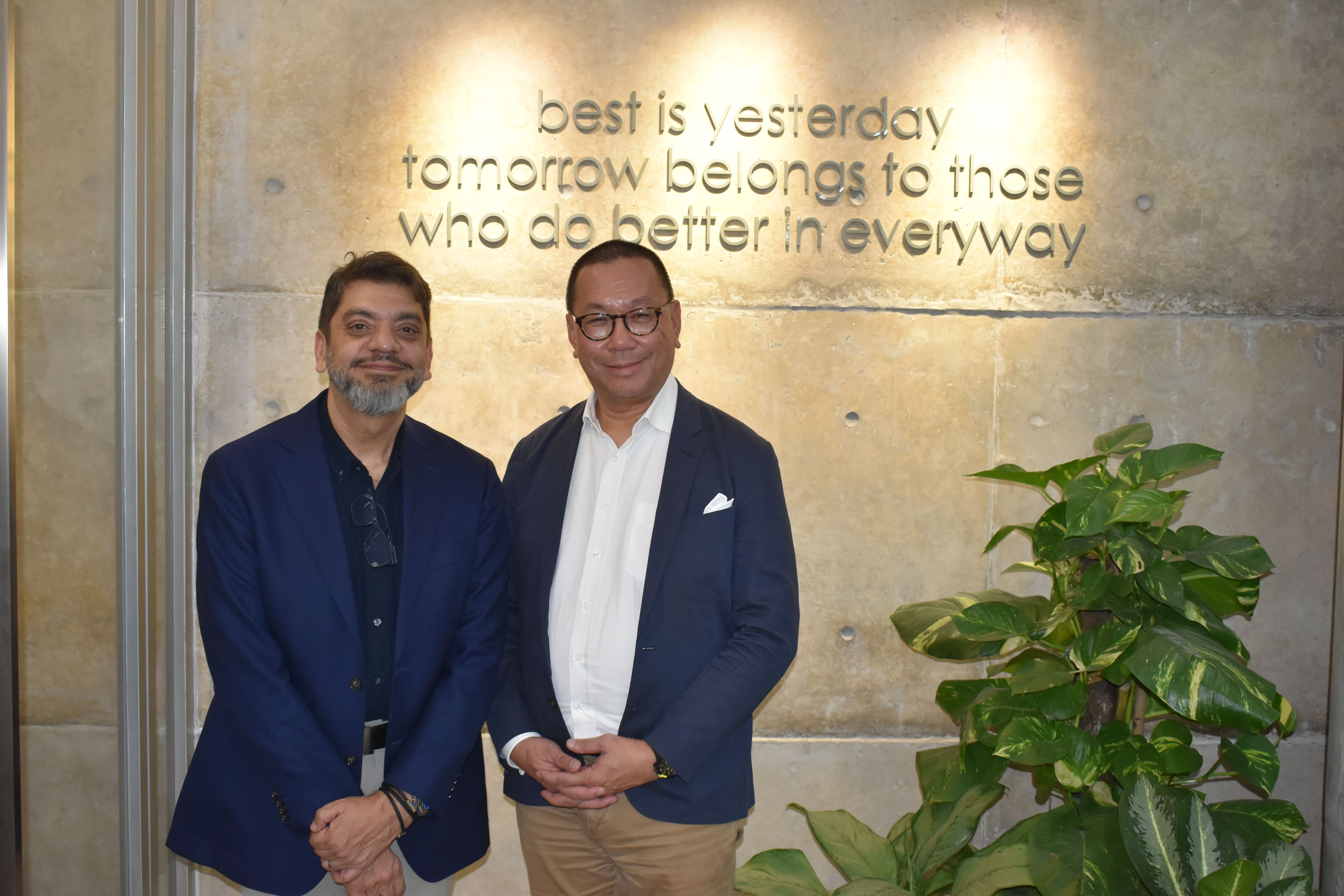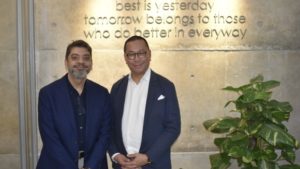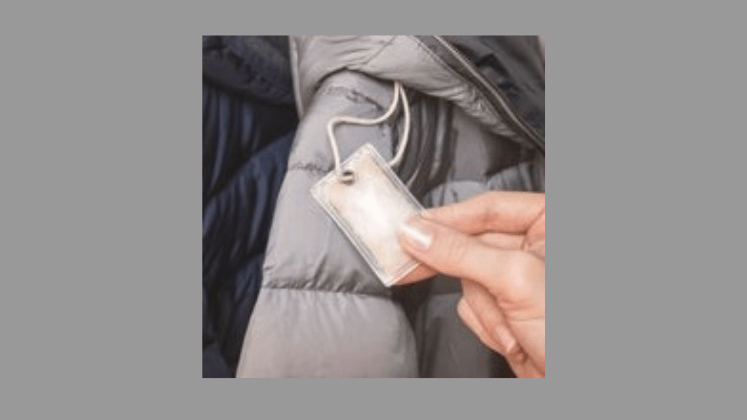
One apparel manufacturing group that has always earned respect from the global apparel industry is Hong-Kong-based EPIC Group that was founded in 1984. The group has been at the forefront of sustainability in all aspects of its manufacturing business model and the organisation focuses on using technology to deliver customer value with speed, efficiency and reliability. EPIC Group proudly believes that it is not just simply about manufacturing products but providing full-service customer solutions which include design, product development, sustainability and innovation in products and processes and order fulfilment.
Team Apparel Resources (AR) recently met Ranjan Mahtani, Executive Chairman and Roger Guy Young, Chief Strategy Officer, EPIC Group in Dhaka (Bangladesh). During the meeting, our team had a freewheeling discussion with Ranjan and Roger about how EPIC Group is doing things differently to be able to support its goals and execute on its ambitious plans.
AR: Being an industry veteran, an observer and Chairman of one of the world’s largest apparel manufacturing groups, what changes have you experienced in the fashion industry in recent times? How is EPIC Group keeping up with market trends?
Ranjan: The industry has gone through tremendous changes in last three years. During Covid-19, things were bad not just for us but for everybody in the industry and we all know that; however, time changed really quickly after the pandemic. Consumers were back on the streets, they decided to go for ‘revenge buying’, and retailers increased their buying capacities after a slump in 2020 and early 2021. All these activities greatly helped the garment manufacturing industry and we were not an exception. Our accounting year is July to June and, in the last Fiscal Year, we experienced a 44 per cent growth on Y-o-Y basis, which is our best performance in almost two decades.
Another trend that we are witnessing today is changing customer order fulfilment process. We do have warehouses in the USA but a part of our shipment is never delivered to these warehouses; instead, we make, ship and deliver directly to retail stores; hence, significantly driving speed and efficiency in the supply chain to meet customer demands – similar to what a domestic brand/retailer does. Today’s young consumers are buying very differently, so each of the stakeholders in the supply chain have to be ready for these changing buying patterns.
However, as we thought that the pandemic woes were over, we have experienced other global challenges: war in Ukraine, economic recession; record inflation in some important buying destinations – which presented us with new challenges. We have developed a very resilient organisation and business model, and we feel it’s all a part of business now, so we are ready to react with tremendous agility as the world changes. We continue to be focused on maintaining our top line. Fortunately, our company has a low debt rate and we maintain a very high cash reserve which is a fundamental necessity to run an organisation, especially during these volatile times
AR: Roger, what’s your way of strategising concepts and how is it benefiting the group?
Roger: If we look at the apparel industry, its ecosystem and end-to-end processes from design to dispatch, it’s a completely different ballgame altogether from the industry in the past. One has to leverage the incredible capabilities of our workforce and of the technology now available in our apparel industry, and create a new vision of an end-to-end value chain in collaboration with new strategic partners in order to thrive. This includes working in new ways with innovative fabric mills, with financial partners, Government, industry and technology partners to build a model for success to meet the needs of a new generation of customers – customers who value sustainability, speed to market, design and value. We continue to focus on sustainability as a critical component to our purpose – using sustainable fabrics, production processes that reduce consumption and waste and do not harm our environment and provide a safe workplace that focuses on employee welfare, development and empowerment.
AR: Digitalisation is today’s requirement in fashion business. How is digitising factories helping you achieve your set goals?
Ranjan: We always endorse sustainable manufacturing business supported by technology and one can see that in our existing factories. All our new factories are fully digitalised that include RFID tags for each garment that track work-in-progress and drive efficiencies throughout the production process. The factories’ data is stored on cloud through an app where all concerned people, including me, can see the performance of operators, sewing lines and even the entire shopfloor in real-time. This process eliminates the need of traditional line managers as the technology tools are going to inform you where the balancing problem is and which line is giving low efficiency so that concerned departments can work accordingly and take decision to improvise processes.
Another important aspect of using RFID is that we have customised all tags because when garments go into washing machines, these RFID tags get destroyed. Customisation has enabled us to improve the strength of tags and now we send all tagged garments into washing machines without worrying about tags being damaged. This way, we are making our supply chain transparent for all.
Our new Bangladesh’s factory is completely digitised and is called ‘micro-factory’. We have face recognition machines for workers in all departments; and we have state-of-the-art digitalised humidity-controlled rooms with dehumidifiers installed to suck out all the moisture from every garment produced in our micro-factory because one of the biggest problems in Bangladesh is high humidity. These are some examples of the digitalisation of our factory processes that we have implemented.
I also believe that a factory has to analyse the cost of technology versus cost of labour. It is very important to have the right software and a balanced automation. Recently, we have looked at producing in the US close to our customers. It makes little sense to produce these T-shirts with manual processes, when you have to pay up to US $ 30 per hour in the US for labour compared to paying US $ 200-250 per month in well-established factories in parts of Asia. Now technology can really change the game in the future, including robotic manufacturing which would make the discussion a very different one. So, we need to give some technologies such as robots at least 10 more years to mark their space in the garment factories.
In the meantime, I think the time is now for ‘Artificial Intelligence’ (AI) in manufacturing. Fabric inspection can be advanced substantially using AI because sensors can detect flaws and defects better than a human being. I personally focus more on AI that gives us an opportunity to do practical investment with faster payback.
Roger: When we talk about digitalisation, we feel 3D design is the present and future. We are leveraging partnerships with technology providers to create samples in 3D that reduce enormous cost, time consumption and increase speed to market. We’re also using predictive analytics so that we can help our customers reduce inventories and tell them in advance what would be the trend next season! We are not just simply manufacturing the products but providing full-service solutions by understanding data end-to-end and speeding up the supply chain. This is greatly helping up reduce inventories, markdown and input costs for our customers
AR: As technology is taking over the garment factories, are workers embracing it, especially in Bangladesh which is a labour-intensive country?
Ranjan: Just imagine a factory with no management personnel except for a team leader at the shopfloor level who is taking care of orders from production to shipment! It is not a far-fetched scenario because the workers are the smartest people we have in our Bangladesh’s factories. They know processes, they take ownership of their work and they want to know how technology works in conjunction with humans. In our factories, workers do not only work on high-end sewing machines but they also want to learn about RFID and IoT technologies that we are using on our shopfloor in order to develop their understanding on how integrating such tools can increase process visibility! Many of these workers, particularly women, have already been promoted to supervisory posts, all because they have understood the advantages of technology and how it enables them to do their work better and faster! We have a great combination of young and smart people in our factories – as they become more and more empowered and technology-enabled, they see incredible opportunity for improvement, job enrichment and career development.
“If we produce 50,000 pieces that need to be washed, we invest in laundry system that can accommodate these quantities; unlike many other factories that have washing capacity in much excess to their actual production capacities which is why they don’t get desired RoI in required time frame.” – Ranjan Mahtani
AR: EPIC Group needs no introduction for its sustainable initiatives. Do you think that the garment factories deserve more support from other stakeholders to scale up industry’s efforts in sustainability at large scale?
Ranjan: Yes, we have invested in sustainability and we will continue doing so in all our new global factories which are equipped with solar panels, ETP membrane, energy-efficient equipment and much more. It all incurs huge amount of cost but we are very measured in our investment. A factory needs to spend money wisely so as to not lose control over financials. The hands-on experience drives strategy and that’s what we do in EPIC.
We are an esteemed organisation when it comes to sustainable practices but what really frustrates me is the fact that no serious investment from stakeholders other than garment factories is being committed. As this collective commitment is lacking in the fashion supply chain, the industry needs to introspect and find answers to these relevant questions – Are we really talking about climate change? Are we serious about landfills and pollution that the fashion industry is accused of contributing to? Are governments stepping up to pour money in making industries sustainable and environment-friendly? Despite much of the efforts being driven by factories that are taking care of processes in the best sustainable ways possible, the garment manufacturers aren’t being given respect, yet we are the ones fully committed to and investing in the sustainability agenda. . We need a collaborative and focused engagement from the other stakeholders also in order to be successful.
AR: EPIC received LEED certification back in 2012 when only a few responsible companies in garmenting were actually talking about GREEN manufacturing. RoI was a major concern at that time which is still a concern as investment in green factories doesn’t give direct payback! Do you feel that these investments help a factory at various levels, along with creating a good image of the factory amongst the industry’s stakeholders?
Ranjan: Building green factories of the future is a very critical element of our expansion strategy at EPIC as green factories are good for people and for our communities, good for the planet and good for business. Green factories help save significant cost of doing business (resource efficiency in utilities and water usage) which ultimately help our environment; improve value; attract new capital; and improve the social and economic health of our communities. Governments are important stakeholders – with sustainability at the top of everyone’s agenda, they must play a key role in supporting manufacturers like ours through investment and fiscal incentives to pave the way to more successfully creating a green future, which then enables capital to be attracted to those industries and sectors driving a green footprint, and ultimately, customers who embrace suppliers committed to advancing responsible manufacturing. We try to help bring together all the stakeholders in this ecosystem – government, industry, communities, financial partners, customers, suppliers and our employees – to the table and ensure a shared vision and mission that moves the needle.
AR: Amidst global uncertainties, do you think non-traditional markets may emerge as beneficiaries for the garment makers?
Ranjan: With a lot of disruptions happening on the global economic landscape, especially in developed economies, it’s difficult to predict what the future may look like. The US consumers are still suffering from high inflation rates, the EU has been undergoing severe energy crisis as Russia-Ukraine war is far from over yet, the US’ trade tension with China is still continuing and stock markets in developed economies continue to be volatile, which, collectively is not at all a good sign for global industries including fashion.
Adding to this is a persistent issue that has remained a growth impediment factor all through 2022 – inventory pile-up! Retailers have unsold inventories worth billions of dollars and these inventories can’t be sold off overnight. Flushing these inventories out will take substantial time and, until they flush it out, they won’t be having buying capacities.
So, yes, garment makers are now relying on non-traditional countries that are emerging as great potential markets. Asia is a house to many such markets including China, Indonesia, South Korea and Vietnam. Another market that I strongly feel largely remains untapped as of yet is India. As things are changing at really quick pace. Indian consumers, who were reluctant to buy products from overseas brands having stores in India, are now showing their intent. Their spending capacities are increasing, all thanks to growing per capita income, which will change Indian fashion retail scenario completely in ten years from today. I believe in-grown lifestyle brands are going to play a crucial role in making fashionable clothing available to a very diverse consumer segment in India.
“We have always endeavoured to become industry leaders in the area of social sustainability and, most importantly, create a transparent, safe and harmonious environment throughout our manufacturing space. I can accept production lapses but if our factory management doesn’t treat our workers in a fair and respectful way, we make the tough calls and take immediate action. We have zero tolerance in these cases.” – Ranjan Mahtani
AR: Please share your long-term plan for EPIC Group.
Ranjan: We have expansion projects to cater to future demands. We have opened up a new factory in Dhaka in December ’22, while Jordan’s mammoth manufacturing project will become operational in March ’23. Jordan’s factory will offer significant duty savings (nearly 30 per cent) for its US customers. The unit is being constructed over 36,000 square metre space that will include a manufacturing site, dedicated dormitories and canteens for the workforce.
In India, we are finalising 35 acres of land in Bhopal (Madhya Pradesh) to open our new factory. We are committed to start our first project in India which will be a vertical set-up that will include four manufacturing units. We are talking to our far-east partners and technical partners to set up a high-end functional fabric unit in this vertical set-up because producing functional fabrics needs the right kind of technology. We are looking to support near-shoring concept in the USA and we are planning to come up with something disruptive soon. We have also kept our options open to receive right funding and partnerships because our intention is to be a company worth US $ 3 billion in the next 5-8 years. Follow EPIC Group on LinkedIn and you’ll read the news on our planned projects.






